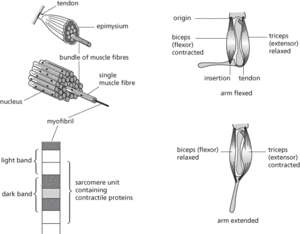Muscle that is generally attached to the skeleton and under the control of the will, although it is also involved in involuntary movements such as breathing and maintaining posture. An individual muscle consists of bundles of long muscle fibres, each bounded by a sarcolemma and containing sarcoplasm, sarcoplasmic reticulum, and many nuclei. The whole muscle is covered with a strong connective tissue sheath (epimysium) and attached at each end to a bone by inextensible tendons. Running through each fibre are smaller fibres (myofibrils) having alternate light and dark bands, which contain protein filaments responsible for the muscle’s contractile ability and give the muscle its typical striped appearance under the microscope. The functional unit of a myofibril is the sarcomere. The end of the muscle that is attached to a nonmoving bone is called the origin of the muscle; the end attached to a moving bone is the insertion. As a muscle contracts, it becomes shorter and fatter, moving one bone closer to the other. Since a muscle cannot expand, another muscle (the extensor) is required to move the bone in the opposite direction and stretch the first muscle (known as the flexor). The flexor and extensor are described as antagonistic muscles.
The speed, strength, and endurance of contractions of a particular muscle are determined by the number of muscle fibres that are contracting at any one time, and the proportions in the muscle of slow-twitch fibres and fast-twitch fibres. See illustration.

Structure and action of a skeletal muscle
- Euler-Maclaurin formula
- Euler multiplier
- Euler number
- Euler numbers
- Euler operators
- Euler pole
- Euler's constant
- Euler, Ulf Svante von
- Euler’s conjecture
- Euler’s constant
- Euler’s equation
- Euler’s equations(fluid dynamics)
- Euler’s formula
- Euler’s identity
- Euler’s method
- Euler’s phi function
- Euler’s rotation theorem
- Euler’s Theorem
- Euler’s theorem
- eulite
- eulogistic/dyslogistic
- eulysite
- Eumetazoa
- EUMETSAT
- EUMETSAT Advanced Retransmission Service